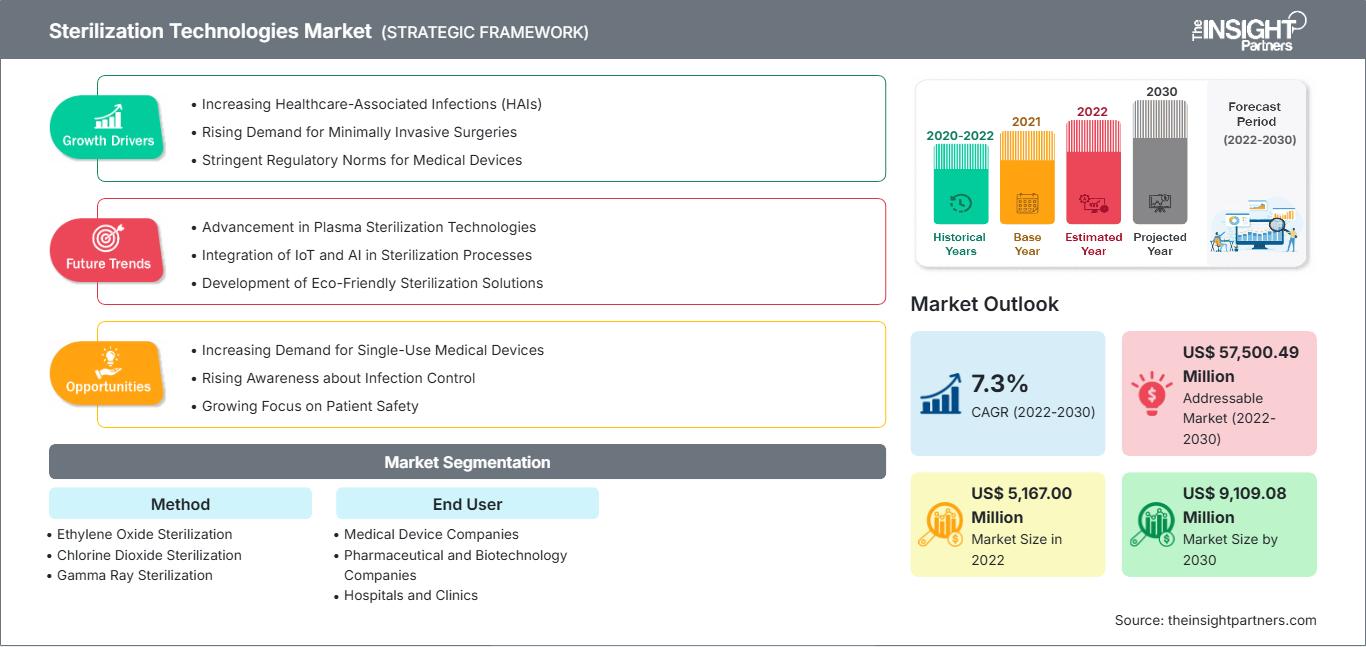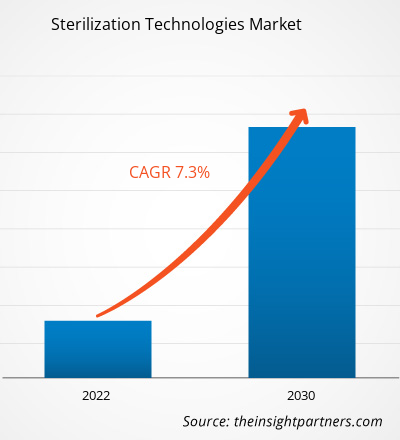Der Markt für Sterilisationstechnologien wird voraussichtlich bis 2031 ein Volumen von 10,42 Milliarden US-Dollar erreichen, gegenüber 6,45 Milliarden US-Dollar im Jahr 2024, und im Zeitraum 2025–2031 eine durchschnittliche jährliche Wachstumsrate (CAGR) von 6,9 % verzeichnen.
Marktanalyse für Sterilisationstechnologien
Die steigende Zahl von Krankenhausinfektionen, strenge regulatorische Standards für Sterilisation und Infektionskontrolle sowie der Trend zu Wiederaufbereitung, Outsourcing und effizienten Sterilisationsprozessen treiben das Wachstum des Marktes für Sterilisationstechnologien an. Die Entwicklung und Anwendung von Niedrigtemperatur-Sterilisationstechnologien, die schonend zu den verwendeten Materialien arbeiten, wird diesem Markt erhebliche Chancen eröffnen.
Marktübersicht Sterilisationstechnologien
Der globale Markt für Sterilisationstechnologien verzeichnet ein signifikantes Wachstum aufgrund der steigenden Nachfrage im Gesundheitswesen, der Pharmaindustrie und der Lebensmittelbranche nach Infektionskontrolle und Produktsicherheit. Die zunehmende Anzahl chirurgischer Eingriffe, die steigende Rate an Krankenhausinfektionen und die strengen regulatorischen Standards sind die Hauptgründe für die verstärkte Nutzung dieser Technologien. Darüber hinaus werden nach wie vor traditionelle Sterilisationsmethoden wie Dampf- und chemische Verfahren eingesetzt.
Der Markt wird durch die zunehmende Akzeptanz von Innovationen beeinflusst, die auf Effizienzsteigerung, kürzere Bearbeitungszeiten und eine verbesserte Prozessnachhaltigkeit abzielen. Nordamerika ist aufgrund seiner etablierten Gesundheitsinfrastruktur führend bei der Technologieeinführung.
Sie erhalten eine kostenlose Anpassung aller Berichte – einschließlich Teilen dieses Berichts, Länderanalysen und Excel-Datenpaketen – sowie attraktive Angebote und Rabatte für Start-ups und Universitäten.
Markt für Sterilisationstechnologien: Strategische Einblicke

-
Ermitteln Sie die wichtigsten Markttrends dieses Berichts.Diese KOSTENLOSE Probe beinhaltet eine Datenanalyse, die von Markttrends bis hin zu Schätzungen und Prognosen reicht.
Markttreiber und Chancen im Bereich Sterilisationstechnologien
Markttreiber:
- Zunehmende Häufigkeit von Krankenhausinfektionen: Der Anstieg von Krankenhausinfektionen hat Gesundheitseinrichtungen dazu veranlasst, in Hightech-Sterilisationsmethoden zu investieren, um die Patientensicherheit zu verbessern, die Infektionsraten zu senken und die Standards für klinische Hygiene und Pflegequalität einzuhalten.
- Strenge regulatorische Standards für Sterilisation und Infektionskontrolle: Die Aufsichtsbehörden im Gesundheitswesen legen strenge Standards für Sterilisation und Infektionskontrolle fest, die Krankenhäuser und Hersteller dazu verpflichten, zertifizierte Sterilisationsverfahren anzuwenden, die Vorschriften einzuhalten und eine sicherere Umgebung für die Patienten zu schaffen, während gleichzeitig die Wahrscheinlichkeit rechtlicher und betrieblicher Risiken verringert wird.
- Hinwendung zu Wiederaufbereitung, Outsourcing und effizienten Sterilisationsabläufen: Durch die Nutzung von Methoden zur Wiederaufbereitung von Medizinprodukten greifen Krankenhäuser zunehmend auf das Outsourcing von Sterilisationsdienstleistungen und die Optimierung von Sterilisationsabläufen zurück, um ihre Ziele der Kostenoptimierung, der Verbesserung der Bearbeitungszeiten und der Steigerung der Ressourcennutzung zu erreichen.
Marktchancen:
- Expansion in Schwellenländern: Die Gesundheitseinrichtungen in Entwicklungsländern werden rasant modernisiert, was die Nachfrage nach Sterilisationstechnologien ankurbelt. Diese Nachfrage wird durch die steigende Anzahl von Operationen, das gestiegene Bewusstsein für Infektionen und den zunehmenden Einsatz moderner Medizinprodukte und Hygienemaßnahmen befeuert.
- Entwicklung und Anwendung von Niedrigtemperatur-Sterilisationstechnologien, die schonend für Materialien sind: Innovative Niedrigtemperatur-Sterilisationsmethoden sind weniger schädlich für empfindliche Geräte, reduzieren Materialschäden und sind effizienter. Dadurch finden sie eine breitere Anwendung in der Medizin-, Pharma- und Biotechnologiebranche und entsprechen gleichzeitig den gesetzlichen Bestimmungen.
- Zunehmende Outsourcing- und Servicemodelle: Um Kosten zu senken, die Effizienz der Arbeitsabläufe zu verbessern und Zugang zu fortschrittlichen Technologien zu erhalten, ohne hohe Kapitalinvestitionen tätigen oder ihre Abläufe verkomplizieren zu müssen, lagern Gesundheitsdienstleister ihre Sterilisationsbedürfnisse zunehmend an spezialisierte Anbieter aus.
Marktbericht zu Sterilisationstechnologien: Segmentierungsanalyse
Der Markt für Sterilisationstechnologien ist in verschiedene Kategorien unterteilt, um ein besseres Verständnis seiner Funktionsweise, seines Wachstumspotenzials und aktueller Trends zu ermöglichen. Nachfolgend ist der in den meisten Branchenberichten verwendete Standard-Segmentierungsansatz dargestellt:
Nach Methode:
- Ethylenoxid: Ethylenoxid ist eine hochwirksame Sterilisationsmethode für hitze- und feuchtigkeitsempfindliche Medizinprodukte. Es dringt tief ein und ist mit diesen Produkten kompatibel.
- Chlordioxid: Chlordioxid ermöglicht eine schnelle Sterilisation bei niedrigen Temperaturen und besitzt eine starke antimikrobielle Wirkung. Es eignet sich zur Behandlung hitzeempfindlicher Geräte sowie zur Wasseraufbereitung und Oberflächendesinfektion.
- Gammastrahlung: Gammastrahlung ist eine Methode mit hoher Durchdringungsfähigkeit, die Einweg-Medizinprodukte und Arzneimittel ohne Hitzeeinwirkung sterilisieren kann. Dadurch wird ein hoher Grad an mikrobieller Inaktivierung erreicht, während gleichzeitig das Material erhalten und die langfristige Produktstabilität gewährleistet wird.
- Elektronenstrahl: Die Elektronenstrahlsterilisation ist eine schnelle Methode der Kaltsterilisation, die für medizinische Geräte, Verpackungen und Arzneimittel eingesetzt werden kann.
- Autoklav-Dampfsterilisation: Die Dampfsterilisation im Autoklaven ist ein Verfahren, bei dem unter hohem Druck stehender gesättigter Dampf zur vollständigen Inaktivierung von Mikroorganismen eingesetzt wird. Es handelt sich um eine weit verbreitete Methode zur Sterilisation von chirurgischen Instrumenten, Laborgeräten und anderen hitzebeständigen Materialien.
- Andere: Die anderen Sterilisationsmethoden, wie Ozon, Wasserstoffperoxidplasma und UV-Licht, sind Niedertemperatur- und umweltfreundliche Optionen, die sich für medizinische und industrielle Anwendungen eignen, die ein hohes Maß an Spezialisierung und Vielseitigkeit erfordern.
Vom Endbenutzer:
- Medizinprodukteunternehmen
- Pharma- und Biotechnologieunternehmen
- Krankenhäuser und Kliniken
- Laboratorien
- Andere
Nach Geographie:
- Nordamerika
- Europa
- Asien-Pazifik
- Lateinamerika
- Naher Osten und Afrika
Der Markt für Sterilisationstechnologien in Nordamerika dürfte einen bedeutenden Marktanteil halten. Zu den treibenden Faktoren zählen die steigende Zahl von Krankenhausinfektionen, strenge regulatorische Standards für Sterilisation und Infektionskontrolle sowie der Trend zu Wiederaufbereitung, Outsourcing und effizienten Sterilisationsprozessen.
Markt für Sterilisationstechnologien – Regionale Einblicke
Die regionalen Trends und Einflussfaktoren auf den Markt für Sterilisationstechnologien im gesamten Prognosezeitraum wurden von den Analysten von The Insight Partners eingehend erläutert. Dieser Abschnitt behandelt außerdem die Marktsegmente und die geografische Verteilung des Marktes für Sterilisationstechnologien in Nordamerika, Europa, Asien-Pazifik, dem Nahen Osten und Afrika sowie Süd- und Mittelamerika.
Marktbericht über Sterilisationstechnologien – Umfang
| Berichtattribute | Details |
|---|---|
| Marktgröße im Jahr 2024 | 6,45 Milliarden US-Dollar |
| Marktgröße bis 2031 | 10,42 Milliarden US-Dollar |
| Globale durchschnittliche jährliche Wachstumsrate (2025 - 2031) | 6,9 % |
| Historische Daten | 2021-2023 |
| Prognosezeitraum | 2025–2031 |
| Abgedeckte Segmente |
Nach Methode
|
| Abgedeckte Regionen und Länder |
Nordamerika
|
| Marktführer und wichtige Unternehmensprofile |
|
Marktdichte der Akteure im Bereich Sterilisationstechnologien: Auswirkungen auf die Geschäftsdynamik verstehen
Der Markt für Sterilisationstechnologien wächst rasant, angetrieben durch die steigende Nachfrage der Endverbraucher. Gründe hierfür sind unter anderem sich wandelnde Verbraucherpräferenzen, technologische Fortschritte und ein wachsendes Bewusstsein für die Vorteile der Produkte. Mit steigender Nachfrage erweitern Unternehmen ihr Angebot, entwickeln innovative Lösungen, um den Kundenbedürfnissen gerecht zu werden, und nutzen neue Trends, was das Marktwachstum zusätzlich beflügelt.

- Verschaffen Sie sich einen Überblick über die wichtigsten Akteure im Markt für Sterilisationstechnologien
Marktanteilsanalyse für Sterilisationstechnologien nach Regionen
Der asiatisch-pazifische Raum wird voraussichtlich in den nächsten Jahren das schnellste Wachstum verzeichnen. Auch die aufstrebenden Märkte in Süd- und Mittelamerika sowie im Nahen Osten und in Afrika bieten Anbietern von Sterilisationstechnologien zahlreiche unerschlossene Möglichkeiten.
Der Markt für Sterilisationstechnologien entwickelt sich aufgrund der Empfehlungen von Aufsichtsbehörden und der medizinischen Leitlinien für Sterilisationstechnologien in den einzelnen Regionen unterschiedlich. Nachfolgend finden Sie eine Zusammenfassung der Marktanteile und Trends der Sterilisationstechnologien nach Regionen:
1. Nordamerika
- Marktanteil: Besitzt einen bedeutenden Anteil am Weltmarkt.
- Wichtigste Treiber: Der Markt wird angetrieben durch ein gut entwickeltes Gesundheitsnetzwerk, strenge Vorschriften und eine begeisterte Übernahme innovativer Sterilisationsmaßnahmen, verbunden mit einem gesteigerten Bewusstsein für Infektionskontrolle.
-
Trends: Fortschritte in der Fertigung und nachhaltige Praktiken
2. Europa
- Marktanteil: Bedeutender Anteil aufgrund der zunehmenden Verbreitung von Schmerzzuständen
- Wichtigste Treiber: Das Marktwachstum wird beschleunigt durch die Notwendigkeit, strenge Vorschriften einzuhalten, gut etablierte Gesundheitssysteme, einen Anstieg chirurgischer Eingriffe und die Vorliebe für effiziente und umweltfreundliche Niedertemperatur-Sterilisationsmethoden.
- Trends: Regulatorischer Einfluss auf die Marktstruktur.
3. Asien-Pazifik
- Marktanteil: Am schnellsten wachsende Region mit jährlich steigenden Marktanteilen.
- Wichtigste Einflussfaktoren: Die Region verzeichnet ein rasantes Wachstum im Gesundheitswesen, was zu einem vermehrten Einsatz medizinischer Geräte führt. Der Infektionsprävention wird mehr Bedeutung beigemessen, und moderne Sterilisationsverfahren finden breite Anwendung.
- Trends: Innovationen bei Sterilisationsprozessen.
4. Süd- und Mittelamerika
- Marktanteil: Wachsender Markt mit stetigem Fortschritt
- Wichtigste Einflussfaktoren: Die Verbesserung der Infrastruktur im Gesundheitswesen, staatliche Initiativen, die Zunahme chirurgischer Eingriffe und der wachsende Trend zur Auslagerung von Sterilisationsdienstleistungen tragen zur Marktexpansion bei.
- Trends: Technologische Entwicklungen in der Herstellung von Sterilisationsgeräten.
5. Naher Osten und Afrika
- Marktanteil: Geringer Marktanteil, der jedoch rasant wächst
- Wichtigste Einflussfaktoren: Zu den Faktoren, die den Einsatz von Sterilisationstechnologien fördern, gehören die Modernisierung des Gesundheitswesens, ein gesteigertes Bewusstsein für Infektionskontrolle, Investitionen in Krankenhäuser und Kliniken sowie die daraus resultierende steigende Nachfrage nach fortschrittlichen Sterilisationsmethoden.
- Trends: Innovationen bei modularen Sterilisationseinheiten
Marktdichte der Akteure im Bereich Sterilisationstechnologien: Auswirkungen auf die Geschäftsdynamik verstehen
Hohe Marktdichte und starker Wettbewerb
Der Wettbewerb ist aufgrund etablierter Unternehmen wie STERIS plc, 3M Company und Getinge AB stark. Regionale und spezialisierte Anbieter wie Atec Pharmatechnik GmbH und Noxilizer, Inc. tragen ebenfalls zur Wettbewerbslandschaft in verschiedenen Regionen bei.
Dieser hohe Wettbewerbsdruck zwingt Unternehmen dazu, sich durch folgende Angebote von der Konkurrenz abzuheben:
- Hochentwickelte Produkte
- Mehrwertdienste wie Anpassung und nachhaltige Lösungen
- Wettbewerbsfähige Preismodelle
- Einhaltung der regulatorischen Richtlinien
Chancen und strategische Schritte
- Unternehmen investieren verstärkt in Forschung und Entwicklung und treiben so Innovationen bei Detektionstechnologien voran. Diese Bemühungen verbessern die Sensitivität und Spezifität und ermöglichen so Lösungen, die auf die unterschiedlichen Bedürfnisse der Augengesundheit in verschiedenen Regionen zugeschnitten sind.
- Die Hersteller werden sich voraussichtlich auf die lokale Produktion konzentrieren, um Kosten zu senken und die Lieferketten zu stärken, insbesondere in Märkten mit hohem Absatzvolumen wie Indien.
Weitere im Rahmen der Studie analysierte Unternehmen:
- Tuttnauer Europe BV
- MMM Group GmbH
- Steelco SpA
- Andersen Sterilizers Inc.
- Shinva Medical Instrument Co., Ltd.
- Stericox India Private Limited
- Forsta MedTech Pvt. Ltd.
Marktneuigkeiten und aktuelle Entwicklungen im Bereich Sterilisationstechnologien
- Sonata Scientific präsentiert Helios MP500: Bahnbrechende Technologie zur Ethylenoxid-Kontrolle (EtO) in Sterilisationsanlagen für Medizinprodukte. Sonata Scientific, ein führender Anbieter fortschrittlicher industrieller Luftreinigung, hat die Markteinführung seines revolutionären Helios MP500 bekannt gegeben – einer Hochleistungslösung zur Eliminierung flüchtiger Ethylenoxid-Emissionen (EtO) in Sterilisationsanlagen für Medizinprodukte.
- Beacon Technology Solutions und Illinois Tech erhalten Fördermittel für Forschung zur Desinfektion mit Fern-UVC-Licht. Beacon Technology Solutions (Beacon) hat in Zusammenarbeit mit dem Illinois Institute of Technology (Illinois Tech) Fördermittel für eine innovative Studie erhalten, die untersucht, wie Fern-UVC-Technologie zur Eindämmung der Ausbreitung von Infektionskrankheiten im öffentlichen Raum beitragen kann. Die Förderung erfolgt über das Illinois Innovation Vouchers (IIV) Programm, das Forschungskooperationen zwischen kleinen und mittleren Unternehmen und den renommierten Universitäten von Illinois fördert.
Marktbericht zu Sterilisationstechnologien: Abdeckung und Ergebnisse
Der Bericht „Marktgröße und Prognose für Sterilisationstechnologien (2021–2031)“ bietet eine detaillierte Analyse des Marktes, die folgende Bereiche abdeckt:
- Marktgröße und Prognose für Sterilisationstechnologien auf globaler, regionaler und Länderebene für alle wichtigen Marktsegmente, die im Geltungsbereich abgedeckt werden
- Markttrends im Bereich Sterilisationstechnologien sowie Marktdynamiken wie Treiber, Hemmnisse und wichtige Chancen
- Detaillierte PEST- und SWOT-Analyse
- Marktanalyse für Sterilisationstechnologien mit globaler und regionaler Betrachtung, Hauptakteuren, regulatorischen Rahmenbedingungen und aktuellen Marktentwicklungen
- Branchenlandschaft und Wettbewerbsanalyse mit Fokus auf Marktkonzentration, Heatmap-Analyse, führende Akteure und aktuelle Entwicklungen im Markt für Sterilisationstechnologien
- Detaillierte Unternehmensprofile
- Historische Analyse (2 Jahre), Basisjahr, Prognose (7 Jahre) mit CAGR
- PEST- und SWOT-Analyse
- Marktgröße Wert/Volumen – Global, Regional, Land
- Branchen- und Wettbewerbslandschaft
- Excel-Datensatz
Aktuelle Berichte
Erfahrungsberichte
Grund zum Kauf
- Fundierte Entscheidungsfindung
- Marktdynamik verstehen
- Wettbewerbsanalyse
- Kundeneinblicke
- Marktprognosen
- Risikominimierung
- Strategische Planung
- Investitionsbegründung
- Identifizierung neuer Märkte
- Verbesserung von Marketingstrategien
- Steigerung der Betriebseffizienz
- Anpassung an regulatorische Trends






















 Kostenlose Probe anfordern für - Markt für Sterilisationstechnologien
Kostenlose Probe anfordern für - Markt für Sterilisationstechnologien